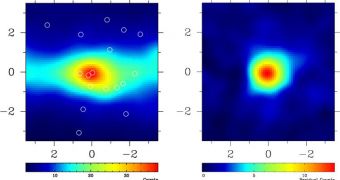According to the conclusions of a new scientific investigation, the recently discovered gamma-ray glow at the core of the Milky Way is produced by high dark matter concentrations at this location.
The results of this study are very important, because proving that dark matter exists could finally certify the Big Bang cosmological model. Conversely, not finding the elusive stuff would pose a great many problems to astrophysicists.
Over the next ten years or so, experts believe, the issue of dark matter will be settled, one way or the other. At this point, the leading theory is that the stuff – which is believed to make up about 24 percent of the Universe's mass-energy budget - is made up of Weakly Interacting Massive Particles (WIMPs).
WIMPs are believed to be their own antimatter particles. Though they seldom interact, they produce very energetic radiations when they do. Additionally, these particles do not readily interact with those that make up baryonic matter.
In fact, dark matter is believed to act on baryonic matter exclusively through the force of gravity. What experiments focused on finding dark matter are trying to do is detect some of those incredibly rare instances when WIMPs do interact with regular matter.
Recently, the American space agency's Fermi Gamma-ray Space Telescope was able to detect excess gamma rays emanating from the galactic center. Details of the study appear in the online scientific journal arXiv, Technology Review reports.
University of California in Irvine (UCI) investigators Kevork Abazajian and Manoj Kaplinghat, the leaders of the new research, say that “there's definitely some source [of gamma-rays at the galactic core], and it fits with the dark matter interpretation.”
But not everyone is satisfied with this interpretation of Fermi's observations. Other scientists believe that the models the UCI team used to simulate the flux of gamma-rays has errors, while some believe that other sources may account for the extra radiations.
However, all agree that, if dark matter is to be found, the galactic center is the best possible place to start looking. According to previous studies, the highest amounts of the stuff should exist at the core, and inside the halos, of large galaxies.

 14 DAY TRIAL //
14 DAY TRIAL //